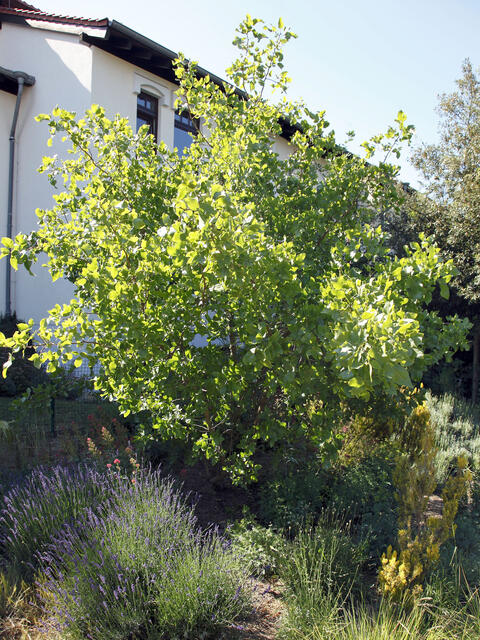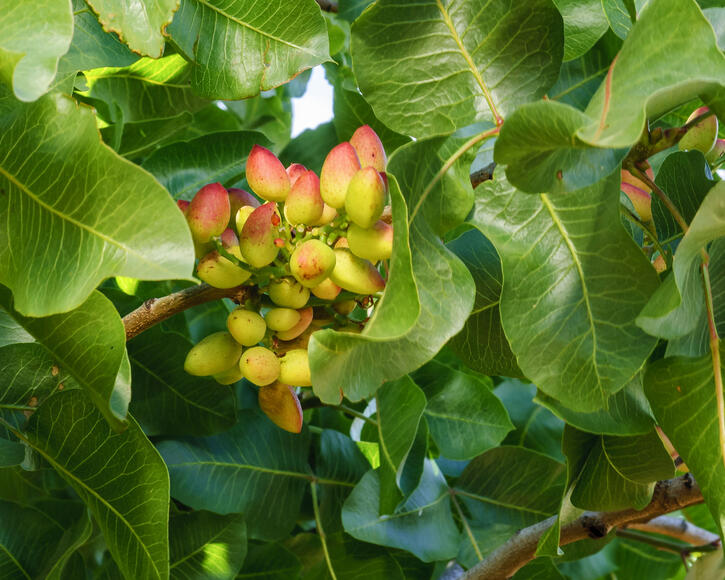Pistachio
The Pistachio tree is an easy-going and very decorative potted plant with an eventful history. It does well in hot and sunny locations.
Factsheet
- Growth type
-
- Tree
- Growth height (from)
- from 300 cm to 500 cm
- Growth characteristics
-
- sweeping
- upright
- Flower color
-
- red
- Flowering time (month)
-
- April
- Flower shape
-
- Cluster
- Flower characteristics
-
- dioecious
- unimpressive
- Leaf color
-
- green
- page format
-
- ovate
- full margined
- feathered
- Fruit color
-
- green
- red
- Fruit shape
-
- Stone fruit
- Light
-
- sunny
- Soil type
-
- gravelly to sandy
- Soil Moisture
-
- moderately dry to fresh
- Decorative or utility value
-
- Fruit ornaments
- Leaf ornaments
- Use
-
- Planters
- Winter garden
- Garden style
-
- Mediterranean garden
- Pot garden
The Pistachio tree is part of a genus with more than ten species of trees that are all native to dry climates from the Mediterranean and Malaysia to Mexico and South America. Many are grown for their foliage, flowers and fruit. The latter applies to Pistacia vera, which produces edible Pistachio nuts. The Pistachio tree originally comes from the Middle East but is now grown in the Mediterranean and southern states of the USA. This ancient cultivated plant probably ended up in Greece thanks to Alexander the Great, then made its way to Sicily. Pistacia vera was probably cultivated from around 7000 BC and found in the Mediterranean since around the first century AD. The Queen of Sheba was said to have declared Pistachio a royal fruit that was only allowed to be grown for personal consumption. Pistacia vera is said to have been grown in the garden of the Babylonian ruler Nebuchadnezzar. The Pistachio tree is now endangered in its homeland.
Although it loses its leaves in temperate zones, the pistachio tree is an evergreen that grows up to 39 feet tall with a branched, sprawling crown. When grown in a pot, Pistacia vera doesn’t grow taller than 16 feet. The trees only survive winter outdoors in zones with mild winters. The bark is grooved and looks like that of oak trees. The trees are dioecious. So if you want fruit, you need a male and a female specimen. But you can buy specimens with grafted branches of both sexes. The roots penetrate up to 49 feet underground to find water in the wild. Pistacia vera can live for up to 300 years.

The alternately arranged, deciduous in the Mediterranean, slightly hairy, ovate leaves of the Pistachio tree are made up of several smooth-edged leaflets. They grow up to 3.94 inches long and are leathery to the touch. Five to three leaflets with a terminal leaflet is typical. The leaves are glossy on both sides, a medium shade of green but sometimes green-gray, and the stem is hairy.
Female and male flowers appear in leaf axils and on different trees - the term for this phenomenon is “dioecious”. They appear in April. The slightly red female flowers appear in double clusters of several hundred individual flowers. The flowers are pollinated by the wind in the wild, but potted specimens may need help with a fine brush.
The Pistacia vera’s female flowers develop into long stone fruits, slightly over 0.39 inches long, with a fleshy green shell. Later, they turn red and then split open. Inside, there is a core with a hard, thin shell housing a seed that is roasted and eaten. The seed itself tends to be triangular and a little squished. The seeds can be pressed to produce an oil used for cooking. Pistachios are usually harvested biannually. The USA, Iran and Turkey are the main producers.

Pistachio trees like it sunny and hot, so a south-facing window - too hot for many plants - is ideal. Pistacia vera is not winter hardy in temperate zones but the plant can tolerate temperatures down to 14 degrees Fahrenheit in short bursts. Potted Pistachio plants like to spend summer in a location protected from wind and rain, on a balcony or terrace, while winter should be spent in a more or less bright location with low temperatures. A darker location would be acceptable, as the Pistachio tree is bare over winter. The tree tolerates dry air well. Any specimens spending winter outside - only an option in zones with very mild winters - need a thick layer of mulch as winter protection.
The Pistachio tree needs potting soil with a high grit content to keep the substrate loose. Lava rocks or pebbles are possible suitable options.
The Pistachio tree requires moderate watering. You can allow the soil to dry out a couple of days between waterings. Then water thoroughly. Alternatively, you can put the whole pot into water so that the plant’s root ball can really soak up the water. You should ideally use lime-free water to water the plant, otherwise unsightly marks will appear on the leaves. However, the plants generally do tolerate water containing lime.
Pistacia vera needs few nutrients. The plant should be fed every 14 days during its growing season using either an organic complete fertilizer in water or fertilizer sticks.
As Pistachio trees grow slowly, they only need repotting every couple years. The plant’s sensitive roots should be handled carefully and damage avoided.

It’s best to prune at the start of the growing season or after the Pistachio nuts have been harvested in early fall. However, it is usually only necessary to remove dead and entangled branches.
Pistacia vera should overwinter at 46 degrees Fahrenheit with a fluctuation range of five degrees. The temperature may even fall to freezing for brief periods. Cool temperatures are necessary to stimulate flowering and fruit production.
Pistacia vera “Kerman” is a female variety, while Pistacia vera “Peters” is male.
Pistacia vera is primarily propagated through sowing seed. Before sowing, leave the seeds to soak in lukewarm water for a few days. The seeds are then sown onto potting soil and covered with soil sparsely so that they are still partially visible. In a bright, warm location, germination will take at least four weeks. In the meantime, the substrate should not dry out. Any seeds that have not opened can be carefully rubbed. The seeds should ideally be sown as soon as possible as this offers the best chances of germination. Experts have been successful with propagation via cuttings taken in late spring. Layering is also an option.
If Pistacia vera is too warm in winter, it may fall foul to aphids. The biggest issues are caused by the substrate being too moist, leading to root rot.

